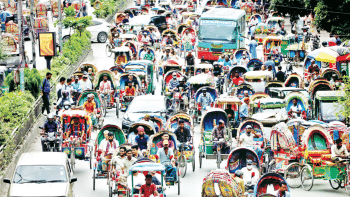Pollution crisis puts children’s health at risk

Bangladesh is grappling with alarming levels of air and noise pollution and electronic waste, all of which pose serious health risks to children, experts cautioned at an event yesterday.
They were speaking at the launch of a new handbook on Children's Health and the Environment at CIRDAP in the capital, jointly organised by the Directorate General of Medical Education and Unicef.
According to the handbook, Bangladesh was ranked the world's most polluted country in 2023, while Dhaka remained the second most polluted city globally between 2018 and 2021. It also noted that in 2021 alone, air pollution caused more than 2,35,000 deaths, including 19,000 children under the age of five.
Household air pollution from burning wood, coal, charcoal, kerosene, animal dung, and crop waste accounted for around 69,000 premature deaths and contributed to a further 13,500 deaths linked to ambient PM2.5 exposure, it added.
Emerging research links prenatal and early childhood exposure to fine particulate matter and nitrogen dioxide with higher risks of autism spectrum disorder, attention-deficit hyperactivity disorder (ADHD) and childhood leukaemia, the handbook mentioned.
It also highlighted that noise pollution has become a major public health hazard, particularly in urban areas.
Dhaka now ranks as the noisiest city among 61 major cities worldwide, with average sound levels reaching 119 decibels, far above the WHO's safe limit of 55 decibels.
Vehicle traffic is the main source, producing 75 percent of the city's noise, with some areas recording levels as high as 110–132 decibels, comparable to a rock concert or chainsaw, it said.
Citing data from Bangladesh Poribesh Andolon, the handbook showed that 5–7 percent of patients at Bangladesh Medical University suffer from noise-induced hearing loss. Children attending schools near busy roads, including Motijheel Ideal School and College and Willes Little Flower School, are already showing signs of harm.
Bangladesh generates an estimated 2.81 million tonnes of e-waste each year, a figure projected to rise to 4.62 million tonnes by 2035, according to research by the Bangladesh University of Engineering and Technology (Buet).
Children living near e-waste recycling sites are exposed to toxic air that can reduce lung function, increase the risk of stillbirth and premature birth, and damage the immune system, growth parameters, DNA and genes.
Reported symptoms include insomnia, headaches, muscle weakness, chest pain and dizziness, the handbook said.
Unicef supported the DGME in developing the document, which is based on the WHO-Unicef online course "Protecting Children's Health from Environmental Threats".
Prof Dr Md Abu Jafor, director general of the Directorate General of Health Services, said, "Our children are among the most affected by climate change, and air pollution is one of the biggest challenges we face. It directly impacts neuroendocrine development, especially in children under five. Around 90 percent of neuronal development occurs within the first six to seven years of life, so preventing air pollution is critically important for protecting their health and future."
Unicef Deputy Representative Deepika Sharma said, "Climate change demands a united response. All concerned organisations must work together to address these challenges and implement effective policies."
Prof Dr Nazmul Hosain, director general of the Directorate General of Medical Education, added, "Strong policy measures are essential to reduce the environmental impacts of climate change. This requires everyone -- government, institutions and communities -- to work in coordination."

 For all latest news, follow The Daily Star's Google News channel.
For all latest news, follow The Daily Star's Google News channel. 







Comments